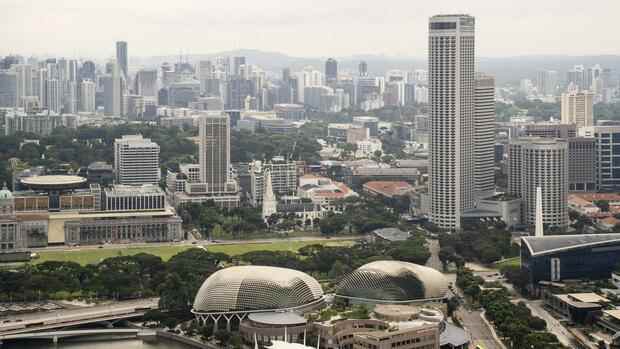The government of the wealthy financial center wants to increase the self-production of food to 30 percent by 2030.
(Photo: Bloomberg)
Bangkok The fish swimming in the tanks off Singapore’s coast are under constant surveillance. A camera system monitors how fast each one of them is growing – and reports skin changes and unusual swimming behavior in order to identify outbreaks of disease as quickly as possible.
The German entrepreneur Dirk Eichelberger uses the data in combination with continuous analysis of the water quality to continuously increase the efficiency of his smart fish farm. “We have managed to increase the growth rate by 20 percent with the same amount of feed and to increase the survival rate of the fish from 60 to over 90 percent,” he says.
Eichelberger sees his company Singapore Aquaculture Technologies as forward-looking. Equipped with technology from Siemens – the Munich group is also on board as an investor – he wants to demonstrate how digitized fish farming can play a central role in the city-state’s search for sustainable food sources.
In addition to the increasing yields, the advantages are obvious from his point of view: Densely populated Singapore does not have to sacrifice any of its extremely scarce land areas for the floating systems. According to the company, breeding in closed tanks reduces pollution of the water bodies. And thanks to local production, CO2 can be saved during transport, says Eichelberger.
Top jobs of the day
Find the best jobs now and
be notified by email.
>> Read here: Digital future: In Singapore, the robot brings lunch
The Southeast Asian island state of Singapore currently obtains almost all of the food it needs for its almost six million inhabitants from abroad. The government of the wealthy financial center wants to change that and is aiming to increase self-production of food to 30 percent by 2030. The primary aim is to make the metropolis more self-sufficient in supply. However, the technologies used also offer the potential to produce in a much more climate-friendly manner.
Vertical farms and meat from the lab
There are now many experiments: in the Tampines district near the airport, researchers are testing the cultivation of rice in the middle of a big city – and are relying on a so-called vertical farm. The method conserves resources: instead of the 2,500 liters of water required for one kilogram of rice in conventional agriculture, only 750 liters are required here.
With a view to the CO2 balance of the multi-storey greenhouses propagated by Singapore, however, questions remain unanswered: According to an analysis by the local university NTU, the energy requirement is significantly higher than in conventional agriculture, but there are no emissions due to long import routes.
It is not yet clear which effect is greater. If the vertical farms switch entirely to renewable energies, the climate contribution would be clearly positive, they say.
The state investment company Temasek from Singapore has founded a start-up together with Bayer that is working on special seeds for use in multi-storey greenhouses.
(Photo: Bayer AG)
The start-ups working on alternative protein sources in Singapore could also contribute to reducing greenhouse gases: Turtletree Labs produces milk in bioreactors and hopes that the technology will reduce the need for herds of cows to emit the climate-damaging gas methane are responsible.
The Californian company Eat Just is currently building a large factory in Singapore that will supply meat from cell cultures. Singapore is the first country in the world to approve laboratory meat. The manufacturer promises that its cell culture chicken meat has a better carbon footprint than raising real hens.
More: How clever agriculture could save the climate
